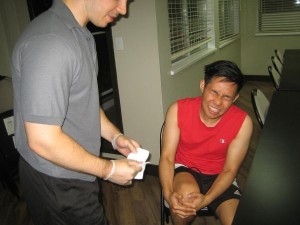
The inflammation of the bursa is called bursitis. The bursa (plural bursae) is the small sac filled with lubricating fluid found between the bone and other moving tissues that include bone, muscle, tendons and the skin that aims to reduce friction, rubbing and irritation. Oftentimes, bursitis is caused by overusing a joint or joint injury. The most common locations for bursitis are the elbow and knees, but bursitis can occur in any joint in the body.
Although bursitis can occur to anyone, it is known to be more common with age. As a person grows older, the tendons lose elasticity, thus they can tolerate less stress and are more prone to tearing. However, certain factors such as, having different forms of arthritis, thyroid disorders or other medications may also increase an individual’s likelihood of developing bursitis. In most cases, bursitis disappears within a few weeks.
Causes of Bursitis
Performing the same repetitive movements every day may lead to adding much pressure on the joints and overusing them leading to bursitis. Moreover, joint injuries may also lead to bursitis. The following scenarios may possibly lead to bursitis:
- Kneeling or leaning on the elbows for a long time
- Prolonged sitting on a hard surface
- Abnormally placed bone or joint
- Gardening
- Shovelling and raking
- Carpentry
- Golf
- Tennis
- Throwing and pitching
- Skiing
- Incorrect work or home posture
- Poor stretching and conditioning before exercise
Symptoms of Bursitis
The following are the most common symptoms of bursitis:
- Arthralgia (joint pain), which may appear abruptly or progressively, and increases in pain upon pressure
- Stiff joint that appears red and swollen
- Loss of motion in the affected joint
First Aid Management for Bursitis
It may be hard to determine whether one is suffering from bursitis or other joint problems however, a visit to the doctor will help in getting the proper diagnosis. In most cases, the application of first aid is the same for all kinds of joint pain, including bursitis. The following are generally recommended in cases of bursitisto decrease pain:
- Rest the affected area and protect from further injury. Immobilize the affected area.
- To reduce swelling, apply ice. However, do not apply ice directly on the skin but instead wrap with a cloth.
- For inflammation and pain management, take over-the-counter (OTC) pain medications such as ibuprofen and naproxen.
- If one sleeps on the side, cushion the knees by placing a small pillow between the legs.
Prevention of Bursitis
The following tips do not guarantee complete avoidance of bursitis, however, they are known to reduce pressure on the joints and may be helpful:
- Follow proper stretching and conditioning before exercise. Warm up.
- If the job requires much pressure on the elbows or knees, wear elbow or kneeling pads, respectively.
- When one lifts weight, follow proper posture by bending the knees.
- Take frequent breaks in between repetitive tasks.
Disclaimer: This article is for general information only and should not substitute professional medical advice. To learn more about bursitis and joint pain, enrol in First Aid Courses with workplace approved training.
